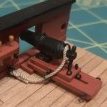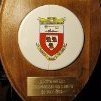Supplies of the Ship Modeler's Handbook are running out. Get your copy NOW before they are gone! Click on photo to order.
×
-
Posts
3,084 -
Joined
-
Last visited
Reputation Activity
-
 Jaager got a reaction from markjay in how do I sharpen my craft knives?
Jaager got a reaction from markjay in how do I sharpen my craft knives?
If you have not nicked the blade, or cut metal, it may be sufficient to strop the edge.
A scrap piece of leather and a bar of green, gold, or rouge compound. "Color" the leather with the compound.
Draw the blade away from the edge.
It is good to do this after every few cuts.
If you have really dulled the edge, a whetstone - most are now synthetic. - with these the edge leads the way.
There are a ton of different but emphatic ways for how to do this out there for the Googling.
It may be more time economical to discard the blades this time - tape them or something - to keep them
from being porcupine quills thru the trash bag. With new blades, strop often and see if they last longer.
There are #11 shaped knives with a wide range of widths - they are not disposable - they are also expensive.
-
 Jaager got a reaction from Canute in how do I sharpen my craft knives?
Jaager got a reaction from Canute in how do I sharpen my craft knives?
If you have not nicked the blade, or cut metal, it may be sufficient to strop the edge.
A scrap piece of leather and a bar of green, gold, or rouge compound. "Color" the leather with the compound.
Draw the blade away from the edge.
It is good to do this after every few cuts.
If you have really dulled the edge, a whetstone - most are now synthetic. - with these the edge leads the way.
There are a ton of different but emphatic ways for how to do this out there for the Googling.
It may be more time economical to discard the blades this time - tape them or something - to keep them
from being porcupine quills thru the trash bag. With new blades, strop often and see if they last longer.
There are #11 shaped knives with a wide range of widths - they are not disposable - they are also expensive.
-
 Jaager got a reaction from Ryland Craze in how do I sharpen my craft knives?
Jaager got a reaction from Ryland Craze in how do I sharpen my craft knives?
If you have not nicked the blade, or cut metal, it may be sufficient to strop the edge.
A scrap piece of leather and a bar of green, gold, or rouge compound. "Color" the leather with the compound.
Draw the blade away from the edge.
It is good to do this after every few cuts.
If you have really dulled the edge, a whetstone - most are now synthetic. - with these the edge leads the way.
There are a ton of different but emphatic ways for how to do this out there for the Googling.
It may be more time economical to discard the blades this time - tape them or something - to keep them
from being porcupine quills thru the trash bag. With new blades, strop often and see if they last longer.
There are #11 shaped knives with a wide range of widths - they are not disposable - they are also expensive.
-
 Jaager got a reaction from BenD in how do I sharpen my craft knives?
Jaager got a reaction from BenD in how do I sharpen my craft knives?
If you have not nicked the blade, or cut metal, it may be sufficient to strop the edge.
A scrap piece of leather and a bar of green, gold, or rouge compound. "Color" the leather with the compound.
Draw the blade away from the edge.
It is good to do this after every few cuts.
If you have really dulled the edge, a whetstone - most are now synthetic. - with these the edge leads the way.
There are a ton of different but emphatic ways for how to do this out there for the Googling.
It may be more time economical to discard the blades this time - tape them or something - to keep them
from being porcupine quills thru the trash bag. With new blades, strop often and see if they last longer.
There are #11 shaped knives with a wide range of widths - they are not disposable - they are also expensive.
-
 Jaager got a reaction from Ryland Craze in Greetings from a newbie!
Jaager got a reaction from Ryland Craze in Greetings from a newbie!
I came across this company ( Wye River ) when I was looking to see if an old company that featured Bay centric small craft had come back to life - Midwest - I think it was.
https://www.wye-river-models.com/shrimping-trawler.html
I have no knowledge of its quality ( or lack of quality ) . The bow looks more open than the boats I saw at Morehead City, NC in the 70's and 80's.
-
 Jaager got a reaction from Oldsalt1950 in Greetings from a newbie!
Jaager got a reaction from Oldsalt1950 in Greetings from a newbie!
I came across this company ( Wye River ) when I was looking to see if an old company that featured Bay centric small craft had come back to life - Midwest - I think it was.
https://www.wye-river-models.com/shrimping-trawler.html
I have no knowledge of its quality ( or lack of quality ) . The bow looks more open than the boats I saw at Morehead City, NC in the 70's and 80's.
-
 Jaager got a reaction from Dave_E in Greetings from a newbie!
Jaager got a reaction from Dave_E in Greetings from a newbie!
I came across this company ( Wye River ) when I was looking to see if an old company that featured Bay centric small craft had come back to life - Midwest - I think it was.
https://www.wye-river-models.com/shrimping-trawler.html
I have no knowledge of its quality ( or lack of quality ) . The bow looks more open than the boats I saw at Morehead City, NC in the 70's and 80's.
-
 Jaager got a reaction from jcooke26 in Greetings from a newbie!
Jaager got a reaction from jcooke26 in Greetings from a newbie!
I came across this company ( Wye River ) when I was looking to see if an old company that featured Bay centric small craft had come back to life - Midwest - I think it was.
https://www.wye-river-models.com/shrimping-trawler.html
I have no knowledge of its quality ( or lack of quality ) . The bow looks more open than the boats I saw at Morehead City, NC in the 70's and 80's.
-
 Jaager got a reaction from mtaylor in Filling gaps in planks #2....
Jaager got a reaction from mtaylor in Filling gaps in planks #2....
Make a few mock ups of planks and gaps. Test fillers on that.
Then try your stain on the tests.
A stain is a surface critter. It is pigment granules in a binder that sits on the surface. A semi-transparent paint.
A dye is dissolved molecules that penetrate the wood and become part of it.
If your wood is Basswood, a stain may be a good choice. The wood itself is not really something to celebrate with a dye and clear finish. If a filler and a stain do not work together, a shellac primer may turn the whole - filler and wood - into a surface that accepts a stain with no difference between patch and wood.
For a dye, you may have to dye the wood flour before mixing it with white PVA (white drys clear) (yellow drys amber).
Or, if the wood flour soaks up too much dye and is too dark, dye the wood before you sand it to make the wood flour (a pre-colored filler).
-
 Jaager got a reaction from catopower in Mary of Norfolk 1790 by KenW - Finished - Pilot Boat
Jaager got a reaction from catopower in Mary of Norfolk 1790 by KenW - Finished - Pilot Boat
I do not think I could cut and apply planks in a way that would match an optimistic subdivision for each plank width for the whole area from the beginning.
If I was starting from scratch, I would start with two battens and define three zones. I may just use one side for both.
It is tricky enough to lay the battens in a way that produces an elegant curve and divides the stem rabbet and stern rabbet with proper room for no drop planks being necessary. Time spent here at the beginning can save a lot of work and heartache later. If you were careful to have a symmetrical hull, trying to get the port batten to mirror the starboard batten may be unneeded. I would pick one side and spot - not bother doing the other one.
The garboard would go on first. The P&S garboard.
Then I would start at the wale and plank the upper zone P&S - using the same pattern for each strake.
The planking fan is a convenient way subdivide. Rather than try to make the location for each strake at the start, I would begin anew at each strake.
i.e.: If the upper zone is 8 strakes, use the fan to define 1/8th for the first strake. Mount it P&S.
Measure the new gap and use the fan to define 1/7th, mount, measure 1/6th, 1/5th, etc.
The last strake for upper zone could be where any difference P&S can be resolved, or go with matched pairs and fix it later. It depends on just how different they were.
Next do the bottom zone next to the keel.
The middle zone is where P can be measured and used there and S measured and done there. Either each strake or just the last one or two.
-
 Jaager got a reaction from KenW in Mary of Norfolk 1790 by KenW - Finished - Pilot Boat
Jaager got a reaction from KenW in Mary of Norfolk 1790 by KenW - Finished - Pilot Boat
I do not think I could cut and apply planks in a way that would match an optimistic subdivision for each plank width for the whole area from the beginning.
If I was starting from scratch, I would start with two battens and define three zones. I may just use one side for both.
It is tricky enough to lay the battens in a way that produces an elegant curve and divides the stem rabbet and stern rabbet with proper room for no drop planks being necessary. Time spent here at the beginning can save a lot of work and heartache later. If you were careful to have a symmetrical hull, trying to get the port batten to mirror the starboard batten may be unneeded. I would pick one side and spot - not bother doing the other one.
The garboard would go on first. The P&S garboard.
Then I would start at the wale and plank the upper zone P&S - using the same pattern for each strake.
The planking fan is a convenient way subdivide. Rather than try to make the location for each strake at the start, I would begin anew at each strake.
i.e.: If the upper zone is 8 strakes, use the fan to define 1/8th for the first strake. Mount it P&S.
Measure the new gap and use the fan to define 1/7th, mount, measure 1/6th, 1/5th, etc.
The last strake for upper zone could be where any difference P&S can be resolved, or go with matched pairs and fix it later. It depends on just how different they were.
Next do the bottom zone next to the keel.
The middle zone is where P can be measured and used there and S measured and done there. Either each strake or just the last one or two.
-
 Jaager got a reaction from Dave_E in Filling gaps in planks #2....
Jaager got a reaction from Dave_E in Filling gaps in planks #2....
Make a few mock ups of planks and gaps. Test fillers on that.
Then try your stain on the tests.
A stain is a surface critter. It is pigment granules in a binder that sits on the surface. A semi-transparent paint.
A dye is dissolved molecules that penetrate the wood and become part of it.
If your wood is Basswood, a stain may be a good choice. The wood itself is not really something to celebrate with a dye and clear finish. If a filler and a stain do not work together, a shellac primer may turn the whole - filler and wood - into a surface that accepts a stain with no difference between patch and wood.
For a dye, you may have to dye the wood flour before mixing it with white PVA (white drys clear) (yellow drys amber).
Or, if the wood flour soaks up too much dye and is too dark, dye the wood before you sand it to make the wood flour (a pre-colored filler).
-
 Jaager got a reaction from Canute in Ratline glue
Jaager got a reaction from Canute in Ratline glue
Thanks for presenting the option.
This may be a reference in the future and I thought that a more complete map of this problem would be useful.
I was not asking for me, The only anything synthetic that I allow myself is PVA and two part epoxy.
I have always considered our project here to be a contest with myself. My rules being what I imagine was available to the English modelers in the 1670 era. But hot pot hide glue is just too much additional bother. No limits on power tools allowed though. The more tools I have- the better it is. I have maxed out on anything with a foot print though.
-
 Jaager got a reaction from Canute in Ratline glue
Jaager got a reaction from Canute in Ratline glue
My first thought was either shellac or bookbinder's white PVA pH7.
But I only consider natural fibers - mainly linen for my rope.
I would guess that older kits featured cotton for rope material.
Is not man-made synthetic polymer line making major inroads as scale rope material now?
This material would lack the pores and gaps needed for PVA to bond.
I know that shellac will play nice with polyurethane but will it hold as a layer on top of a plastic?
What holds on a polymer line?
@Univ of Saigon 68If your Bluenose is one of the old Scientific kits, the line is probably cotton, so shellac or PVA would be ideal.
Has anyone reanimated the old Scientific brand name and started producing new material? The old kits were "mostly harmless" as a beginner kit and fun to build.
-
 Jaager got a reaction from mtaylor in Ratline glue
Jaager got a reaction from mtaylor in Ratline glue
Thanks for presenting the option.
This may be a reference in the future and I thought that a more complete map of this problem would be useful.
I was not asking for me, The only anything synthetic that I allow myself is PVA and two part epoxy.
I have always considered our project here to be a contest with myself. My rules being what I imagine was available to the English modelers in the 1670 era. But hot pot hide glue is just too much additional bother. No limits on power tools allowed though. The more tools I have- the better it is. I have maxed out on anything with a foot print though.
-
 Jaager got a reaction from mtaylor in Ratline glue
Jaager got a reaction from mtaylor in Ratline glue
My first thought was either shellac or bookbinder's white PVA pH7.
But I only consider natural fibers - mainly linen for my rope.
I would guess that older kits featured cotton for rope material.
Is not man-made synthetic polymer line making major inroads as scale rope material now?
This material would lack the pores and gaps needed for PVA to bond.
I know that shellac will play nice with polyurethane but will it hold as a layer on top of a plastic?
What holds on a polymer line?
@Univ of Saigon 68If your Bluenose is one of the old Scientific kits, the line is probably cotton, so shellac or PVA would be ideal.
Has anyone reanimated the old Scientific brand name and started producing new material? The old kits were "mostly harmless" as a beginner kit and fun to build.
-
 Jaager got a reaction from Canute in "Work bench" feed back please
Jaager got a reaction from Canute in "Work bench" feed back please
You may consider using a 2 inch thick "brick" of rigid Styrofoam wall insulation. PVC glue it to a plywood base and punch holes for your tools. Having multiple bricks - each oriented to a general task - they store on a shelf. Sharp pointed or edged tools are held vertical and the material does not affect the edge.
-
 Jaager got a reaction from mtaylor in Seeking advice on how to edge bend 0.6x5mm sapelli for second planking
Jaager got a reaction from mtaylor in Seeking advice on how to edge bend 0.6x5mm sapelli for second planking
I am not a wood products scientist, I have not done the experiments to back this up. The available evidence seems to support:
A strip of wood that is rectangular in cross section, does not "want" to bend in the thick plane. It will twist instead.
The solution is to spill the plank. Start with a wide board and trace out the "S" shape of the plank shape needed on it. It is then cut out and the rest is spilled / spoiled in Cockney(?) -wasted.
The wood species that you are using is a poor choice. The stock that you have is not wide enough to do its job.
To bend wood, the lignin binder needs weaken its hold. Lignin is insoluble in water. What weakens its hold temporarily is heat. With a thick piece of wood, steam is an efficient way to get heat into the interior. At model plank scale, steam is usually not necessary. Heat alone will do the job. Water just swells the fibers and messes up a smooth surface.
Soaking a plank may refill the cellulose tubes with water. What that does is undo all the time spent in seasoning (drying) it. Water will not reanimate it. It was actually dead while it was a part of a living tree. Wood will equilibrate with the water concentration in its atmosphere. Humidity varies with the weather. So does the water content in lumber but with a significant lag. It will not get drier than this, unless forced. Old brittle wood is just wood that has always been brittle. It was crap to begin with.
Wood fibers are cellulose tubes. They really do not slide along each other all that much. They stretch and pull apart on one side and crush and kink on the other with a bend - if it is still growing the new layers can adapt. Some species are more forgiving in how much bending that they will allow. There is a limit for any species.
-
 Jaager got a reaction from trippwj in Making ship drawings in the seventeenth century Dutch Republic.
Jaager got a reaction from trippwj in Making ship drawings in the seventeenth century Dutch Republic.
The second quote was not any sort of criticism. I was trying to say that the plan may be also valid for a shell first construction. In their zeal to protect their rice bowl, the shell first guild may have hidden methods that were sophisticated and technically complicated. The plan may actually reflect what they did. They did not need to do the work to draft a preliminary plan.
On the first quote, I was in agreement with you. When I first read what was involved with shell first, I saw the initial form of the hull bottom as having a random factor - a -what Nature allows you- factor. The keel, stem and stern planned.
The three frames planned. It obviously worked for them and they resisted fixing what was not broke well into the 18th century. I do not expect that the random possibilities for model scale wood planks to be a good predictor of what wood will allow on an actual full size build.
I reacted to "experiment". I have a background in wet bench basic biochemical pharmacology. Experiment, to me, means a certain discipline is involved. (I was wise enough to realize that experimental science was a bad fit for me and I was fortunate enough to have a fall back gig that was lucrative enough.)
If the term is meant in a colloquial sense, that sort of "experiment" does not have a p value to support the result. Someone who repeats it in exactly the same way, is not likely to get a different result. For a speculative model: When what information that does exist is used in an organized manner and best guess assumptions that are compatible with existing evidence is used to fill in the gaps, then valid or reasonable results are possible. The assumptions used to perform it need to be documented. It just takes the falsification of a basic assumption to invalidate. One of the assumptions would be a planned prediction of the bottom planking would do, rather than accepting what it does at model scale.
-
 Jaager got a reaction from flying_dutchman2 in Making ship drawings in the seventeenth century Dutch Republic.
Jaager got a reaction from flying_dutchman2 in Making ship drawings in the seventeenth century Dutch Republic.
The second quote was not any sort of criticism. I was trying to say that the plan may be also valid for a shell first construction. In their zeal to protect their rice bowl, the shell first guild may have hidden methods that were sophisticated and technically complicated. The plan may actually reflect what they did. They did not need to do the work to draft a preliminary plan.
On the first quote, I was in agreement with you. When I first read what was involved with shell first, I saw the initial form of the hull bottom as having a random factor - a -what Nature allows you- factor. The keel, stem and stern planned.
The three frames planned. It obviously worked for them and they resisted fixing what was not broke well into the 18th century. I do not expect that the random possibilities for model scale wood planks to be a good predictor of what wood will allow on an actual full size build.
I reacted to "experiment". I have a background in wet bench basic biochemical pharmacology. Experiment, to me, means a certain discipline is involved. (I was wise enough to realize that experimental science was a bad fit for me and I was fortunate enough to have a fall back gig that was lucrative enough.)
If the term is meant in a colloquial sense, that sort of "experiment" does not have a p value to support the result. Someone who repeats it in exactly the same way, is not likely to get a different result. For a speculative model: When what information that does exist is used in an organized manner and best guess assumptions that are compatible with existing evidence is used to fill in the gaps, then valid or reasonable results are possible. The assumptions used to perform it need to be documented. It just takes the falsification of a basic assumption to invalidate. One of the assumptions would be a planned prediction of the bottom planking would do, rather than accepting what it does at model scale.
-
 Jaager got a reaction from flying_dutchman2 in Making ship drawings in the seventeenth century Dutch Republic.
Jaager got a reaction from flying_dutchman2 in Making ship drawings in the seventeenth century Dutch Republic.
I was envisioning this key first step: the garboard and first belt of planking that would then be fixed in place using the floor timbers - as having its shape determined by the bending of the boards. A model can mimic what is thought to be shape of the original. Using it to predict what could have been allowed by full size planking pushed to its extreme is not likely to be a good technique. I see that assumptions and fudge factors come into play with a model. I was being somewhat absolute about the input for a true experiment in possible hull conformations allowed by the original methods.
I see models as being excellent at replication. I see them as being limited as being predictors of the behavior of full size materials.
Shipbuilding in the Age of Sail was entirely a series of one off experiments that had no real controls. The bad practices were obvious enough. Getting a hull with maximum efficiency was something that was only chased.
-
 Jaager got a reaction from flying_dutchman2 in Making ship drawings in the seventeenth century Dutch Republic.
Jaager got a reaction from flying_dutchman2 in Making ship drawings in the seventeenth century Dutch Republic.
If the model was built the same way as the actual ship was built, a free floating shell - the result would probably be unreliable at best. The material - wood - is the same - more or less. The bending and other physical characteristics would not scale. Since Nature's math is Calculus, the differences due to scale would be more than a linear proportion. Trying to use the technique at scale as a predictor of full size behavior would probably yield a failure.
If the full size shape was drawn, and scaled, and molds or frames made to that shape, these would be able to provide for a model that Was an accurate representation.
England was using plans at this time - the method used was one of various derivatives of whole molding. The example with three frames and the stern structure is what was used to get the mathematical data on paper in whole molding. The batten part that came next was art and finesse for getting the lines. Those preliminary whole molding plans were probably enough to get the bureaucracy off their backs. Rather than try to get wood to match some planed shape, they took what the wood allowed them. Their battens were full sized on the ways, instead of slivers on a drawing board. It would be constant frustration for the customer that was a bureaucracy wanting cookie cutter predictability. It is frustration for those who wish to replicate in miniature what they built .
Whole molding uses very basic geometric tools - straight lines and arcs. These guild based shipwrights were probably doing basically the same things. Instead of committing it to paper before they started, they probably did it either in their heads, or did drawings that were one off for each part and that were discarded after use. My bet is that the plans version of whole molding came from someone breaking the rules and committing to paper what the guild had been doing for quite a while. It just took a Royal to get too involved in the actual work for someone to gain profit by revealing guild secrets.
For the actual ships at the time and in the place at issue here, we have no evidence that significantly sophisticated plans were used. The problem is: it is necessary to have these sort of plans to build a ship model that is an actual 'model'. It is a great gift from Ab Hoving and to our advantage that a way has come to us to generate plans for these otherwise lost vessels that way produces a reasonable approximation of their form and shape..
About Ab Hoving's place in this: To repeat myself, the skills and mental prospective required to be a pathfinder is different from the telephone sanitizers who follow on to tighten things up, apply the polish, and make a big deal of deficiencies the original path did not include. Pathfinders deserve honors and respect. They are rare and cannot be willed into existence. The education system is geared to produce an endless supply of telephone sanitizers. Their contributions are obviously useful but are only incremental.
-
 Jaager got a reaction from Charles Green in Seeking advice on how to edge bend 0.6x5mm sapelli for second planking
Jaager got a reaction from Charles Green in Seeking advice on how to edge bend 0.6x5mm sapelli for second planking
I am not a wood products scientist, I have not done the experiments to back this up. The available evidence seems to support:
A strip of wood that is rectangular in cross section, does not "want" to bend in the thick plane. It will twist instead.
The solution is to spill the plank. Start with a wide board and trace out the "S" shape of the plank shape needed on it. It is then cut out and the rest is spilled / spoiled in Cockney(?) -wasted.
The wood species that you are using is a poor choice. The stock that you have is not wide enough to do its job.
To bend wood, the lignin binder needs weaken its hold. Lignin is insoluble in water. What weakens its hold temporarily is heat. With a thick piece of wood, steam is an efficient way to get heat into the interior. At model plank scale, steam is usually not necessary. Heat alone will do the job. Water just swells the fibers and messes up a smooth surface.
Soaking a plank may refill the cellulose tubes with water. What that does is undo all the time spent in seasoning (drying) it. Water will not reanimate it. It was actually dead while it was a part of a living tree. Wood will equilibrate with the water concentration in its atmosphere. Humidity varies with the weather. So does the water content in lumber but with a significant lag. It will not get drier than this, unless forced. Old brittle wood is just wood that has always been brittle. It was crap to begin with.
Wood fibers are cellulose tubes. They really do not slide along each other all that much. They stretch and pull apart on one side and crush and kink on the other with a bend - if it is still growing the new layers can adapt. Some species are more forgiving in how much bending that they will allow. There is a limit for any species.
-
 Jaager got a reaction from Gregory in Seeking advice on how to edge bend 0.6x5mm sapelli for second planking
Jaager got a reaction from Gregory in Seeking advice on how to edge bend 0.6x5mm sapelli for second planking
I am not a wood products scientist, I have not done the experiments to back this up. The available evidence seems to support:
A strip of wood that is rectangular in cross section, does not "want" to bend in the thick plane. It will twist instead.
The solution is to spill the plank. Start with a wide board and trace out the "S" shape of the plank shape needed on it. It is then cut out and the rest is spilled / spoiled in Cockney(?) -wasted.
The wood species that you are using is a poor choice. The stock that you have is not wide enough to do its job.
To bend wood, the lignin binder needs weaken its hold. Lignin is insoluble in water. What weakens its hold temporarily is heat. With a thick piece of wood, steam is an efficient way to get heat into the interior. At model plank scale, steam is usually not necessary. Heat alone will do the job. Water just swells the fibers and messes up a smooth surface.
Soaking a plank may refill the cellulose tubes with water. What that does is undo all the time spent in seasoning (drying) it. Water will not reanimate it. It was actually dead while it was a part of a living tree. Wood will equilibrate with the water concentration in its atmosphere. Humidity varies with the weather. So does the water content in lumber but with a significant lag. It will not get drier than this, unless forced. Old brittle wood is just wood that has always been brittle. It was crap to begin with.
Wood fibers are cellulose tubes. They really do not slide along each other all that much. They stretch and pull apart on one side and crush and kink on the other with a bend - if it is still growing the new layers can adapt. Some species are more forgiving in how much bending that they will allow. There is a limit for any species.
-
 Jaager got a reaction from RichardG in "Work bench" feed back please
Jaager got a reaction from RichardG in "Work bench" feed back please
You may consider using a 2 inch thick "brick" of rigid Styrofoam wall insulation. PVC glue it to a plywood base and punch holes for your tools. Having multiple bricks - each oriented to a general task - they store on a shelf. Sharp pointed or edged tools are held vertical and the material does not affect the edge.













